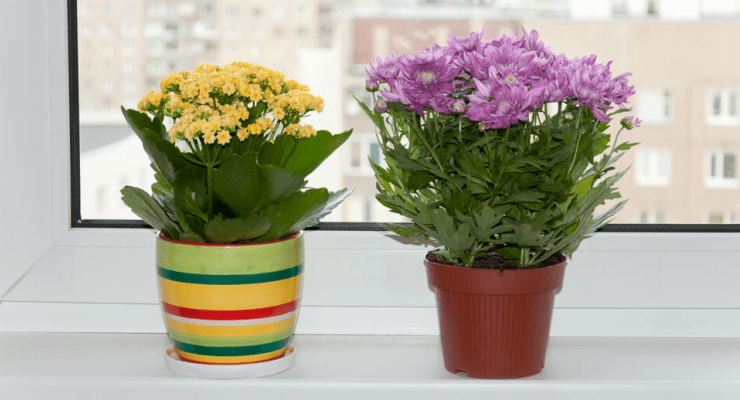Houseplants add a lot to the home. They bring the outdoors in and even improve the air quality of the home. You may look around your home, however, and discover that you have focused on foliage plants. Having something blooming in the home would be nice. Too many people, though, think that many flowering houseplants are difficult to grow. Such is not the case. Here are five rather unusual flowering houseplants that you might like to try.
Kaffir Lily (Clivia)
The kaffir lily has long — 1½-foot — strap-like, thick, waxy dark green leaves. Leafless stems shoot out from the middle carrying clusters of 12-20 tubular flowers, which generally bloom in the winter and spring. Most, such as C. miniata, have flowers that are salmon-red on the outside with yellow on the inside. The ‘Grandiflora,’ however, has large bright red blooms.
Caring for the kaffir lily is really quite easy. Plant it in average potting soil. It does prefer a bright spot in the house but can deal with average temperatures and humidity. Allow the soil to dry out between waterings. Once it has ceased to bloom, you will only need to give it enough water to keep it from wilting until it once again begins to produce new growth. During the spring and summer months, fertilize with a balanced fertilizer about every six weeks. Kaffir lilies really do not like to have their roots disturbed, so avoid a lot of repotting. Whenever you do decide to repot, take divisions for more plants.
Natal Palm (Carissa grandiflora)
The natal palm has shiny dark green leaves and long forked spines on the stems. It generally grows to about 2½-feet tall. It can produce small clusters of flowers at any time during the year. The waxy white blooms are 1½-2 inches across and are fragrant. Each bloom has a long tube that ends in five flat lobes. Natal palms will also produce an edible fruit that is tart and tastes a bit like cranberries.
Plant your natal palm in an average potting mix that is kept moist. Fertilize every 3-4 months with a balanced fertilizer. It does like direct light; although, it can stand average temperatures and humidity. Prune to keep it compact and propagate from stem cuttings. It only needs to be repotted when it becomes root-bound.
King’s Mantle (Thunbergiaerecta)
The king’s mantle belongs to the same family as the vining black-eyed Susan and is just as easy to grow. It can grow to be 6-feet tall. It produces 3-inch blue or white blooms in the summer.
Plant in average potting soil and place in an area where it can get direct sunlight. Young plants should be watered only moderately. When they begin to bloom, keep the soil evenly moist. and fertilize about every 2 weeks. Remove spent flowers to extend the bloom period.
Dwarf Oleander (Nerium oleander)
This hybrid grows to be 3-4 feet tall. The leaves are narrow and a dull dark green. The flowers that are usually produced in the spring and summer have 5 petals and can be white, yellow, pink, rose, or reddish-purple. Note: All parts of this plant are poisonous; therefore, you might want to avoid it if you have small children and/or pets.
Plant in an average potting soil. Plant in an area where they can get sun all year. They do fine in average room temperatures but can actually benefit from slightly cooler room temperatures during the winter months. Water thoroughly, allowing the soil to dry out slightly between waterings. During the growing period, fertilize with a balanced fertilizer about every 2 weeks.
New Guinea Hybrid (Impatiens)
Most people grow this plant as an annual and toss it at the end of the season. I like to keep mine going all year. The New Guinea hybrid is a bushy plant, growing to be 10-16 inches high. The variegated leaves can be found in y3llow and green or pink and green. The flowers are much larger than other impatiens and can be bright orange, pink, or red.
Plant in average potting soil and place in bright light. Allow the soil to dry out slightly between thorough waterings. Do not allow them to get too dry, though, or they will immediately wilt. They will bounce back, however, if you water them before they completely die. During their active growing period, fertilize with a balanced fertilizer about every 2 weeks. You can easily propagate by taking stem cuttings.
So,there are five great flowering business houseplants. They are easy-grow, easy-care, which makes them a perfect addition to your houseplant collection.
For buyng bouquet, see: https://www.secretflorists.com/flower-bouquet/
Houseplants: Determining Light Levels in Your House
Watering Houseplants: Identifying Problems
Houseplants: Understanding Fertilizer
References:
DeWolf, Jr., Gordon P. Taylor’s Guide to Houseplants. Boston, MA: Houghton Mifflin Company, 1987.
Horan, Anne and Robert G. Mason, eds. Flowering Houseplants. Richmond, VA: Time-Life Books, 1990.


